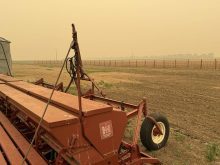WINNIPEG – Canadian National Railway says “creeping re-regulation” of grain transportation is prompting it to delay grain related investments.
Wayne Atamanchuk, assistant vice-president for bulk commodities for CN, said changes to the revenue cap in recent years are “seriously eroding” the railway’s returns from hauling grain.
“Western Canadian export grain is one of the least profitable commodities for us,” he told a transportation conference last week.
As a result, the railway has decided to delay indefinitely grain-specific investments, such as new hopper cars or upgrades to rail sidings.
Read Also

Farmland advisory committee created in Saskatchewan
The Saskatchewan government has created the Farm Land Ownership Advisory Committee to address farmer concerns and gain feedback about the issues.
“We’re in a holding pattern,” he told reporters later.
“I’m not saying we’re never going to make investments, but we’re waiting to see how the future unfolds.”
CN is scheduled to spend $1.4 billion on system-wide capital investments in 2008 and that will go ahead. Included in that is $430 million to be spent on western Canadian infrastructure.
However, Atamanchuk said those numbers will be lower next year and grain will be at the bottom of the priority list.
He said the railway’s concerns about re-regulation are based on recent changes to the revenue cap, which uses a complicated formula to establish each year a limit on how much the two national railways can earn from moving grain.
He cited the Canadian Transportation Agency’s recent decision to reduce the cap by some $70 million to more accurately reflect hopper car maintenance costs. CN has challenged that decision in Federal Court.
The CN official said that it seems that every year the agency tinkers with the formula to impose more limits on revenues under the cap.
“It’s changing from where we started, with the intent, I think, of trying to constrain the revenues eligible to be earned by the railways,” said Atamanchuk.
In 2007, CN had net income of $2.16 billion, up from $2.09 billion in 2006.
Revenue from hauling grain and fertilizer (lumped together for reporting purposes) was $1.31 billion in 2007 and $1.26 billion in 2006.
That represents about 16 percent of total railway revenues.
Atamanchuk said he was unable to calculate exactly the financial impact those changes in the revenue cap have had on CN’s revenue from grain hauling.
“What concerns us is the trend rather than the actual magnitude,” he said.
Mark Hemmes, head of the federal grain monitoring agency Quorum Corp., rejected suggestions that changes to the cap represent creeping re-regulation.
While there have been adjustments to deal with a few minor issues, there has been no significant change since it was implemented in 2001.
However, Hemmes added he does believe there is the potential for some re-regulation in the grain transportation system.
The most likely area for action would be on an issue known in the industry as “balanced accountability.”
Shippers of grain and other commodities have been lobbying hard for a system that would impose performance penalties on the railways similar to those levied by the railways against shippers.
“They are strongly advocating for that and there is a real possibility it could happen,” said Hemmes.
He added the industry and government are coming to the realization that allowing so-called free competition to rule is problematic with a system limited to two strong railways.
There is some feeling in the industry that creating competition through regulation may be the answer.
Atamanchuk said there is already effective competition between the railways, noting that 84 percent of CN’s grain shipments originate within 80 kilometres of a high throughput elevator on a Canadian Pacific Railway line.
He said consolidation of grain handling companies has given them more clout when negotiating freight arrangements with the rail companies and there are already considerable regulatory safeguards such as the revenue cap, interswitching rules and final offer arbitration.
Robert McLean, a farmer from Manitou, Man., and vice-president of Keystone Agricultural Producers, said there is no evidence that changes in the past decade have resulted in more competition between the railways.
There are more service complaints now, he added, and most are decided in favour of the shippers.
McLean said the CTA has done a good job protecting the interests of small shippers and farmers, but more needs to be done, including a full costing review to determine the real costs of moving grain and to ensure farmers are receiving a fair deal.














